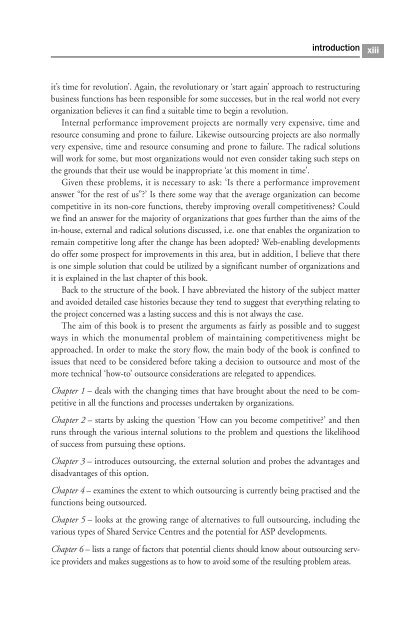The Outsourcing Dilemma - The Search for Competitiveness.pdf
The Outsourcing Dilemma - The Search for Competitiveness.pdf
The Outsourcing Dilemma - The Search for Competitiveness.pdf
Create successful ePaper yourself
Turn your PDF publications into a flip-book with our unique Google optimized e-Paper software.
introduction<br />
xiii<br />
it’s time <strong>for</strong> revolution’. Again, the revolutionary or ‘start again’ approach to restructuring<br />
business functions has been responsible <strong>for</strong> some successes, but in the real world not every<br />
organization believes it can find a suitable time to begin a revolution.<br />
Internal per<strong>for</strong>mance improvement projects are normally very expensive, time and<br />
resource consuming and prone to failure. Likewise outsourcing projects are also normally<br />
very expensive, time and resource consuming and prone to failure. <strong>The</strong> radical solutions<br />
will work <strong>for</strong> some, but most organizations would not even consider taking such steps on<br />
the grounds that their use would be inappropriate ‘at this moment in time’.<br />
Given these problems, it is necessary to ask: ‘Is there a per<strong>for</strong>mance improvement<br />
answer “<strong>for</strong> the rest of us”’ Is there some way that the average organization can become<br />
competitive in its non-core functions, thereby improving overall competitiveness Could<br />
we find an answer <strong>for</strong> the majority of organizations that goes further than the aims of the<br />
in-house, external and radical solutions discussed, i.e. one that enables the organization to<br />
remain competitive long after the change has been adopted Web-enabling developments<br />
do offer some prospect <strong>for</strong> improvements in this area, but in addition, I believe that there<br />
is one simple solution that could be utilized by a significant number of organizations and<br />
it is explained in the last chapter of this book.<br />
Back to the structure of the book. I have abbreviated the history of the subject matter<br />
and avoided detailed case histories because they tend to suggest that everything relating to<br />
the project concerned was a lasting success and this is not always the case.<br />
<strong>The</strong> aim of this book is to present the arguments as fairly as possible and to suggest<br />
ways in which the monumental problem of maintaining competitiveness might be<br />
approached. In order to make the story flow, the main body of the book is confined to<br />
issues that need to be considered be<strong>for</strong>e taking a decision to outsource and most of the<br />
more technical ‘how-to’ outsource considerations are relegated to appendices.<br />
Chapter 1 – deals with the changing times that have brought about the need to be competitive<br />
in all the functions and processes undertaken by organizations.<br />
Chapter 2 – starts by asking the question ‘How can you become competitive’ and then<br />
runs through the various internal solutions to the problem and questions the likelihood<br />
of success from pursuing these options.<br />
Chapter 3 – introduces outsourcing, the external solution and probes the advantages and<br />
disadvantages of this option.<br />
Chapter 4 – examines the extent to which outsourcing is currently being practised and the<br />
functions being outsourced.<br />
Chapter 5 – looks at the growing range of alternatives to full outsourcing, including the<br />
various types of Shared Service Centres and the potential <strong>for</strong> ASP developments.<br />
Chapter 6 – lists a range of factors that potential clients should know about outsourcing service<br />
providers and makes suggestions as to how to avoid some of the resulting problem areas.















